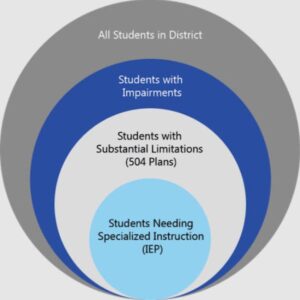 In last week’s post we talked about some of the basics involved with 504 Plans (504 Plans – The Reality : Part I ).
In last week’s post we talked about some of the basics involved with 504 Plans (504 Plans – The Reality : Part I ).
Remember, that a 504 does not offer any interventions, but accommodations. It is intended to provide equal access to the mainstream to those identified as having a disability. By far, ADHD is the disorder that receives the most 504 plans in school.
Of the things (among many) that raises my “IQ” (i.e., Irritation Quotient), are 504 accommodations that seem rubber-stamped or given by default.
A classic example is the provision of extra time, which is the top of the list of accommodations typically offered to ADHD children. (Not sure I’ve ever seen a 504 Plan that doesn’t give extra time as its top accommodation.)
To illustrate and expand upon my irritation, let’s look at Carl, an impulsive child who rushes through his work (and practically everything else he does). Diagnosed by his pediatrician with ADHD, the parents took the physician’s prescription with a request for a 504 to the school.
The team met with the parents and set up a 504. Among a few other accommodations at the top of the list was the provision of extra time (i.e., double time) on tests and classroom activities.
Given Carl’s characteristic impulsive style, the last thing Carl needs (or wants) is extra time.
As Carl blitzes through everything, it’s unclear how double-time helps Carl, as he is finishing a typical fifteen minute task in under three minutes (without checking any of his work).
Perhaps, rather than giving Carl extra time, which doesn’t help him at all, they can have the teacher’s assistant slowly go through his answers to help him to double check them, something he rarely to never does.
As you go into yo.ur 504 meetings try and have an open and honest conversation (admittedly, not easy to do) regarding your child.
To guide the discussion there should be one central question. That is, “What are the few things that can be done to help the child to function more effectively in the classroom?” If time extension isn’t helpful, then don’t put it in the 504.
Takeaway Point
Be practical and realistic. Come up with two or three things that you think would legitimately help your child
Keep it simple. Keep asking the central question.
(***Please note: All blogs represent the opinion and perspective of Dr. Richard Selznick. Comments and questions are welcomed, but are blocked by the hosting site. Please email questions or comments: rselznick615@gmail.com)
 Copyright, Richard Selznick, Ph.D. 2022, www.shutdownlearner.com.
Copyright, Richard Selznick, Ph.D. 2022, www.shutdownlearner.com.
To Contact Dr. Richard Selznick for advice, consultation or other information, email rselznick615@gmail.com.
To receive future blog posts, register your email: https://shutdownlearner.com.
